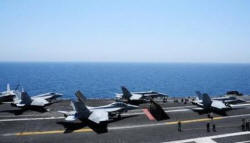|
 As
U.S. faces new threats, Pentagon seeks bigger defense budget As
U.S. faces new threats, Pentagon seeks bigger defense budget
 Send a link to a friend
Send a link to a friend
[February 03, 2015]
By David Alexander and Andrea Shalal
WASHINGTON (Reuters) - Facing new security
challenges in the Middle East and Ukraine, the Obama administration on
Monday proposed an increased $534 billion Pentagon base budget plus $51
billion in war funds as it urged Congress to end cuts it says erode U.S.
military power.
|
|
 Defense officials said the higher spending level was necessary to
carry out President Barack Obama's national security strategy,
including the planned stationing of more forces in the Asia-Pacific
in response to the rise of China. Defense officials said the higher spending level was necessary to
carry out President Barack Obama's national security strategy,
including the planned stationing of more forces in the Asia-Pacific
in response to the rise of China.
The proposed base budget exceeded the $499 billion federal spending
cap for fiscal year 2016, forcing a debate with Congress over
whether to continue deep cuts to federal discretionary spending or
to amend the limits set in a 2011 law that sought to narrow the U.S.
budget deficit.
Defense officials acknowledged the request exceeded federal spending
limits, but General Martin Dempsey, the chairman of the Joint Chiefs
of Staff, said the budget "represents the minimum resource level
necessary to remain a capable, ready and appropriately sized force
able to meet our global commitments."
Defense officials said the budget included funding for additional
P-8 submarine-hunter aircraft and development of a new long-range
strike aircraft seen as necessary for the Asia-Pacific region.
 The proposed budget included $5.3 billion to fund operations against
Islamic State militants in Syria and Iraq, including $1.3 billion to
train and equip Syrian opposition fighters.
To reassure European allies worried about Russia's actions in
Ukraine and elsewhere in the region, it proposed $789 million to
bolster U.S. military rotational deployments and increase military
exercises and training with partners in Europe.
"The geopolitical events of the past year only reinforce the need to
resource DoD (Department of Defense) at the president's requested
funding level as opposed to current law," the Pentagon said in a
statement.
The budget follows several years of deep cuts, also known as
sequestration. Projected defense spending was supposed to be reduced
by about a trillion dollars over a decade but defense officials say
the cuts are eroding military capabilities after 15 years of war.
[to top of second column] |

"As the budget makes clear, a return to sequester-level funding
would be irresponsible and dangerous, resulting in a force too small
and ill-equipped to respond to the full range of potential threats
to the nation," the Pentagon said.
The proposed budget would enable the U.S. Army to fund an
active-duty force of 475,000 soldiers, down slightly from its plan
to retain 490,000 after the wars in Iraq and Afghanistan. The
Pentagon has warned that if the 2011 budget limits remained in
force, it would have to cut the Army to about 420,000 troops.
The Pentagon again sought approval for several reforms hotly opposed
in Congress, including retirement of the A-10 "Warthog" close-air
support aircraft, conducting a new round of U.S. base closures and
curbing the rising cost of military pay and benefits.
(Additional reporting by Phil Stewart and David Brunnstrom; editing
by David Storey, G Crosse and Cynthia Osterman)
[© 2015 Thomson Reuters. All rights
reserved.]
Copyright 2015 Reuters. All rights reserved. This material may not be published,
broadcast, rewritten or redistributed.

 |